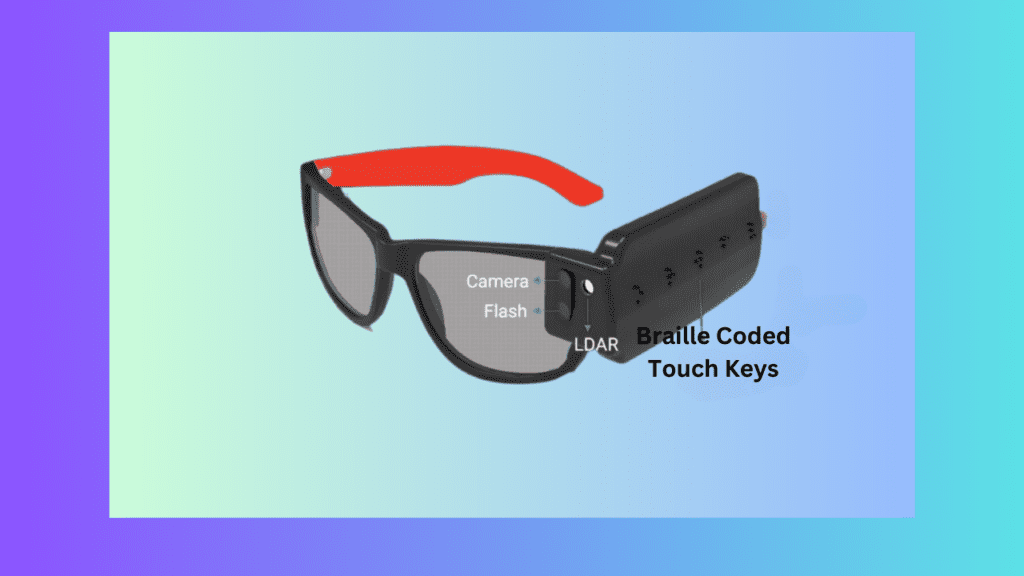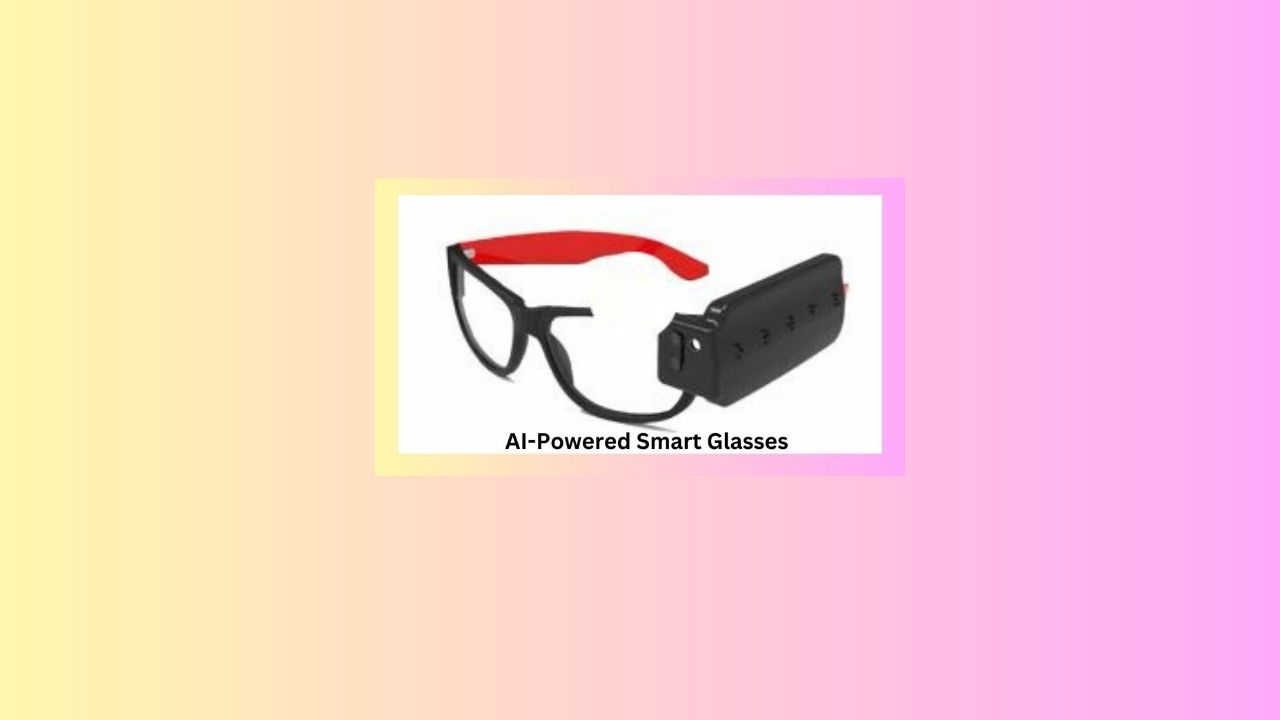The AI glasses for the Blind, called Smart Vision Glasses, use a combination of computer vision, artificial intelligence, and machine learning to provide a variety of features that can help blind people navigate their surroundings, read text, and identify objects.
Some of the features of the AI Glasses Glasses include:
- Object detection: The glasses can use their camera to identify objects in the user’s surroundings and provide audio feedback about the object. For example, if the user is walking down the street, the glasses can tell them if there is a car coming, a pedestrian crossing the street, or a step up ahead.
- Text reading: The glasses can also read text out loud to the user. This can be helpful for blind people who want to read books, newspapers, or signs. The glasses can also read text from a computer or smartphone screen.
- Navigation: The glasses can use GPS and other sensors to help the user navigate their surroundings. This can be helpful for blind people who are traveling to a new place or who are trying to find their way around a crowded area.
- Safety: The glasses also have a number of safety features, such as an alarm that can be triggered if the user gets too close to an object or if they start to wander off.
How do AI glasses work?
AI glasses utilize a combination of computer vision, machine learning, and sensor technology to provide real-time visual assistance to individuals with visual impairments. These glasses are equipped with miniature cameras that capture the user’s surroundings, which are then processed by sophisticated algorithms.
The AI algorithms analyze the visual data and convert it into auditory or tactile feedback, allowing the user to perceive the world in a way that is accessible to them.
The cameras in AI glasses capture a continuous stream of images, which are then analyzed by the AI algorithms in real time. These algorithms can detect and identify objects, people, text, and other visual elements within the user’s field of view.
The glasses then provide audio or tactile cues to convey this information to the user. For example, the glasses may use voice commands or haptic feedback to describe objects, read out text, or alert the user to potential hazards in their environment.
AI glasses also incorporate advanced sensors, such as depth sensors and infrared technology, to provide additional information about the user’s surroundings. These sensors help to enhance depth perception, detect obstacles, and improve the overall accuracy of the AI glasses’ visual recognition capabilities.
Benefits of AI glasses for the blind
Enhancing independence and mobility
One of the most significant benefits of AI glasses for the blind is the enhanced independence and mobility they offer. With AI glasses, blind individuals can navigate their surroundings more confidently and safely. The glasses can identify and locate objects in real-time, allowing users to avoid obstacles and navigate unfamiliar environments with ease. This newfound independence empowers blind individuals to travel independently, explore new places, and engage in activities that were previously inaccessible to them.
Improving safety and obstacle detection
AI glasses play a crucial role in improving the safety and well-being of blind individuals. By detecting and alerting users to potential hazards, such as low-hanging branches or uneven terrain, these glasses help prevent accidents and injuries.
The glasses can also assist in navigating crowded spaces, alerting users to the presence of people or objects in their path. This enhanced safety feature gives blind individuals the confidence to move around more freely and engage in daily activities without constant assistance.
Enabling better communication and social interaction
AI glasses are not only useful for navigating physical environments but also for improving communication and social interaction. These glasses can recognize faces and provide real-time information about the people a user encounters. This feature allows blind individuals to engage in more meaningful conversations, as they can receive cues about the facial expressions and emotions of others.
The glasses can also provide real-time text-to-speech conversion, enabling blind individuals to read and respond to written messages, such as text messages or emails, independently.
Facilitating access to information and education
Another significant benefit of AI glasses for the blind is their ability to facilitate access to information and education. These glasses can read text from books, documents, or signs, and convert it into audio or tactile feedback for the user.
This feature allows blind individuals to access printed information without relying on Braille or audiobooks. AI glasses also have the potential to revolutionize education for the blind, as they can provide real-time visual assistance in the classroom, enabling students to participate fully in lessons and activities.
Overcoming challenges and limitations of AI glasses
While AI glasses offer numerous benefits for the blind, they are not without their challenges and limitations. One of the main challenges is the cost of these devices, as they can be quite expensive due to the advanced technology they incorporate. Additionally, AI glasses may require regular software updates to ensure optimal performance and compatibility with evolving technologies.
It is important to manage expectations and understand that AI glasses are not a cure for blindness but rather a tool to enhance independence and accessibility.
Examples of successful AI glasses for the blind
Several companies and organizations have developed AI glasses specifically designed for the blind. One notable example is OrCam MyEye, which uses a portable camera attached to glasses to read text, recognize faces, and identify objects in real time.
Microsoft’s Seeing AI, is a smartphone app that uses AI technology to provide audio descriptions of the user’s surroundings, read text, and recognize faces.
Another is Smart Vision Glasses from shgtechnologies.com

Image Source: shgtechnologies.com
Details of Smart Vision Glasses:
- The glasses are powered by a small battery that lasts for about 4 hours on a single charge.
- The glasses are equipped with a camera, a microphone, and a speaker.
- The glasses are compatible with a variety of smartphones and computers.
- The glasses are available in a variety of languages, including English, Hindi, and Kannada.
Smart Vision Technology
Smart Vision Glasses are a promising new technology that has the potential to improve the lives of blind people. The glasses are affordable, easy to use, and they offer a variety of features that can help blind people navigate their surroundings, read text, and identify objects. I am excited to see how this technology develops in the future.
The SHG Technologies AI smart vision glasses do not actually allow blind people to see. Instead, they use a combination of computer vision, artificial intelligence, and machine learning to provide a variety of features that can help blind people navigate their surroundings, read text, and identify objects.
The glasses have a camera that captures images of the user’s surroundings. These images are then sent to a cloud-based AI engine, which analyzes the images and identifies objects and text. The AI engine then sends the results back to the glasses, which are then spoken aloud to the user.
For example, if the user is walking down the street, the glasses can identify objects such as cars, pedestrians, and steps. The glasses can also read text from signs, menus, and other objects.
Safety Features:
The glasses also have a number of safety features, such as an alarm that can be triggered if the user gets too close to an object or if they start to wander off.
These successful examples demonstrate the potential of AI glasses to revolutionize the lives of blind individuals and pave the way for further advancements in assistive technology.
Future advancements and potential applications
As technology continues to evolve, the potential applications of AI glasses for the blind are expanding rapidly. Future advancements may include improved accuracy and recognition capabilities, enhanced integration with other assistive devices, and the ability to provide more detailed and realistic visual feedback.
One promising area of development is the integration of AI glasses with augmented reality (AR) technology. By overlaying digital information onto the user’s field of view, AR-enabled AI glasses could provide even more comprehensive and immersive visual assistance.
For example, users could receive real-time navigation instructions or access additional information about their surroundings through virtual overlays.
The future of AI glasses for the blind holds immense potential for transforming the lives of visually impaired individuals, offering new opportunities for independence, inclusion, and empowerment.
Conclusion
AI glasses for the blind represent a groundbreaking innovation in assistive technology, enabling visually impaired individuals to see the world in ways they never thought possible. These remarkable devices harness the power of artificial intelligence to enhance independence, improve safety, facilitate communication, and provide access to information and education.
While AI glasses have their challenges and limitations, they offer a remarkable breakthrough in assistive technology and a glimpse into a future where blindness is no longer a barrier to living a full and inclusive life.
With ongoing advancements and continued innovation, AI glasses have the potential to transform the lives of countless individuals, allowing them to see beyond the darkness and embrace a world of possibilities.
For more smart gadgets, visit niraktech.com


